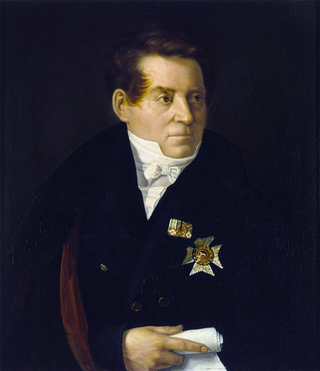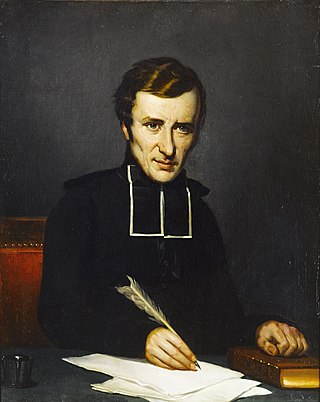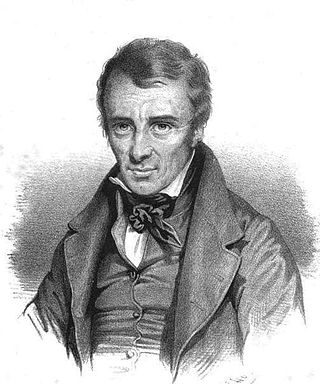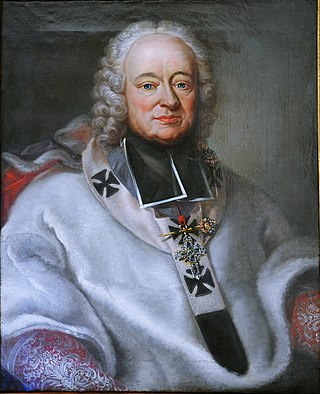
Friedrich Wilhelm Joseph Schelling, later von Schelling, was a German philosopher. Standard histories of philosophy make him the midpoint in the development of German idealism, situating him between Johann Gottlieb Fichte, his mentor in his early years, and Georg Wilhelm Friedrich Hegel, his one-time university roommate, early friend, and later rival. Interpreting Schelling's philosophy is regarded as difficult because of its evolving nature.

August WilhelmSchlegel, usually cited as August Schlegel, was a German Indologist, poet, translator and critic, and with his brother Friedrich Schlegel the leading influence within Jena Romanticism. His translations of Shakespeare turned the English dramatist's works into German classics. Schlegel was also the professor of Sanskrit in Continental Europe and produced a translation of the Bhagavad Gita.

Johann Joachim Winckelmann was a German art historian and archaeologist. He was a pioneering Hellenist who first articulated the differences between Greek, Greco-Roman and Roman art. "The prophet and founding hero of modern archaeology", Winckelmann was one of the founders of scientific archaeology and first applied the categories of style on a large, systematic basis to the history of art. Many consider him the father of the discipline of art history. He was one of the first to separate Greek Art into periods, and time classifications.

Charles-Forbes-René, comte de Montalembert was a French publicist, historian and Count of Montalembert, Deux-Sèvres, and a prominent representative of liberal Catholicism.

Félicité Robert de La Mennais was a French Catholic priest, philosopher and political theorist. He was one of the most influential intellectuals of Restoration France. Lamennais is also considered the forerunner of both liberal Catholicism and Modernism.

François Couperin was a French Baroque composer, organist and harpsichordist. He was known as Couperin le Grand to distinguish him from other members of the musically talented Couperin family.

Karl Christian Friedrich Krause was a German philosopher whose doctrines became known as Krausism. Krausism, when considered in its totality as a complete, stand-alone philosophical system, had only a small following in Germany, France, and Belgium, in contradistinction to certain other philosophical systems that had a much larger following in Europe at that time. However, Krausism became very popular and influential in Restoration Spain not as a complete, comprehensive philosophical system per se, but as a broad cultural movement. In Spain, Krausism was known as "Krausismo", and Krausists were known as "Krausistas". Outside of Spain, the Spanish Krausist cultural movement was referred to as Spanish Krausism.

Marc René, marquis de Montalembert was a French military engineer and writer, known for his work on fortifications.

Liberal Catholicism was a current of thought within the Roman Catholic Church influenced by classical liberalism and promoting the separation of church and state, freedom of religion in the civic arena, expanded suffrage, and broad-based education. It was influential in the 19th century and the first half of the 20th, especially in France. It is largely identified with French political theorists such as Felicité Robert de Lamennais, Henri Lacordaire, and Charles Forbes René de Montalembert influenced, in part, by a similar contemporaneous movement in Belgium.

Jean Delville, born Jean Libert, was a Belgian symbolist painter, author, poet, polemicist, teacher, and Theosophist. Delville was the leading exponent of the Belgian Idealist movement in art during the 1890s. He held, throughout his life, the belief that art should be the expression of a higher spiritual truth and that it should be based on the principle of Ideal, or spiritual Beauty. He executed a great number of paintings during his active career from 1887 to the end of the second World War expressing his Idealist aesthetic. Delville was trained at the Académie des Beaux-arts in Brussels and proved to be a highly precocious student, winning most of the prestigious competition prizes at the Academy while still a young student. He later won the Belgian Prix de Rome which allowed him to travel to Rome and Florence and study at first hand the works of the artists of the Renaissance. During his time in Italy he created his celebrated masterpiece L'Ecole de Platon (1898), which stands as a visual summary of his Idealist aesthetic which he promoted during the 1890s in his writings, poetry and exhibitions societies, notably the Salons d'Art Idéaliste.
Charles Cahier was a French antiquarian, born in Paris on February 26, 1807.

Anne-François-Louis Janmot was a French painter and poet.

François Duquesnoy or Frans Duquesnoy was a Flemish Baroque sculptor who was active in Rome for most of his career, where he was known as Il Fiammingo. His idealized representations represented a quieter and more restrained version of Italian baroque sculpture, and are often contrasted with the more dramatic and emotional character of Bernini's works, while his style shows a great affinity to Algardi's sculptures.

Guillaume-René Meignan was a French Catholic apologist and scriptural exegete, Archbishop of Tours and cardinal.

Henri François Xavier de Belsunce de Castelmoron was a French Jesuit who served as Bishop of Marseille from 1709 until his death. He is remembered for his tireless efforts to relieve the suffering during the Great Plague of Marseille of 1720–21.

Carl Friedrich von Rumohr was a German art historian, writer, draughtsman and painter, agricultural historian, connoisseur of and writer about the culinary arts, art collector and patron of artists.

Charles-Nicolas Cochin was a French engraver, designer, writer, and art critic. To distinguish him from his father of the same name, he is variously called Charles-Nicolas Cochin le Jeune, Charles-Nicolas Cochin le fils, or Charles-Nicolas Cochin II.

Henri Desclée (1830–1917) and Jules Desclée were Belgian brothers, known as founders of Maredsous Abbey, and of two printing business for Roman Catholic literature, the Société Saint-Jean l'Évangéliste and Desclée De Brouwer.

Louis René Bréhier was a French historian who specialized in Byzantine studies. His brother was the philosopher Émile Bréhier.

Gérard de Lacaze-Duthiers was a French writer, art critic, pacifist and anarchist.


















